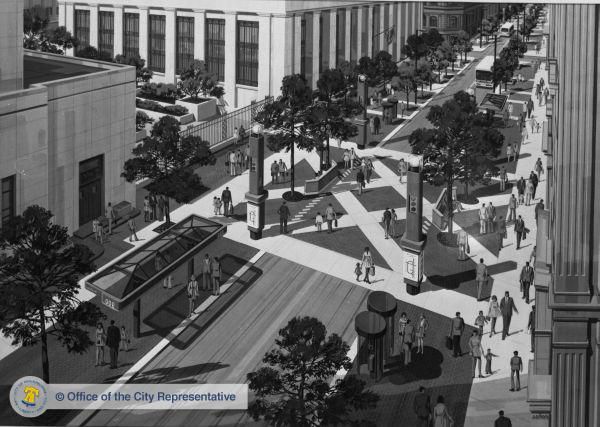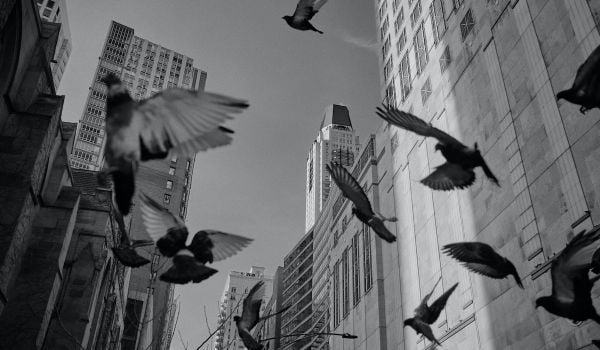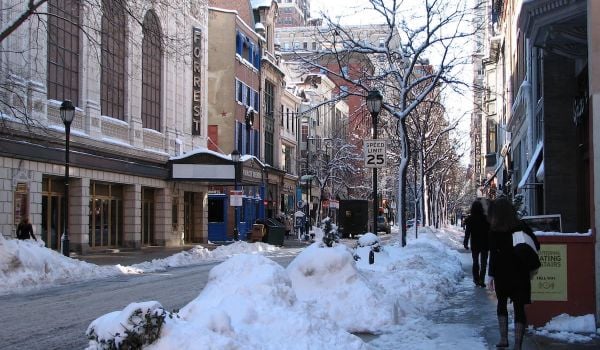Back in 1976, in keeping with the thinking of local planning giant Ed Bacon (“Clean Air, No Gangs, No Private Cars”), Philadelphia closed off Chestnut Street between 8th Street and 18th Street to private cars, creating the Chestnut Street Transway. The idea was that completely closing the street to cars would increase foot traffic, but the actual result was to sap it of pedestrian life. Immediately Chestnut Street began to decline, as shops closed and moved to Walnut Street or left the city altogether.
The city overlearned the lesson of the Transway for decades, using population decline as an excuse to stretch out and liberally supply parking whenever possible. But at Thursday’s DesignPhilly event “Corridor Realities” hosted by the city’s commerce department and the Community Design Collaborative, there were encouraging signs that Philadelphia has been digesting Bacon’s insights about the tension between cars and foot traffic. In cooperation with some of the more enlightened corners of city government, many community development corporations, architects, designers, planners and others are setting their sights on new ways of putting cars in their place and restoring pedestrian energy to struggling corridors.
Brian Syzmanik of MAKE Architecture gave an example of how excessively high levels of service for cars have damaged a retail cluster on East Girard Avenue, where MAKE recently collaborated with the New Kensington Community Development Corporation on a Model Block demonstration project:
East Girard is a very desolate street so we’re trying to slow down traffic, we’re trying to fill any vacant properties on the block, and we’re also looking to attract lots of people who don’t come there now…
East Girard Avenue is a huge street. It has about eight lanes of traffic that should run at 35 miles per hour but can sometimes be more like 65. There are red lights that are run regularly. That’s our existing condition – a big giant street with not a lot of parking. We began by asking the question how can we make it less like a highway? How can we make it less imposing?
The MAKE crew came up with some ideas for “squishing” this stroad with street furniture and various illusions to make the corridor feel more walkable and pedestrian friendly, and the building results are impressive. But pedestrian conditions on East Girard Ave aren’t any less appalling. The street is still too wide, and that’s holding back its mixed-use retail corridors.
Syzmanik proved that talented private individuals’ efforts can go a very long way, but that’s not quite enough. Political choices about the allocation of street space, the width of moving lanes, the presence or absence of bus lanes, and the level of service for different modes of transportation (including pedestrians) can have a big impact on the viability of businesses and real estate.
Just like with the Chestnut Street Transway, misallocating street space or designing streets to accommodate only cars or only transit can destroy wealth and render commercial properties unattractive to businesses and their customers. Bacon’s “No Private Cars” mantra was too radical for his day, when the nation’s car culture was ascendant, and it is too radical now. But there is growing agreement that fewer privatecars is key to successful neighborhood retail clusters.
That was an underlying theme of several other presentations at Thursday’s event, from Robin Kohles’ recommendation of herringbone-patterned sidewalk bump-outs for Fabric Row, to Pam Zimmerman’s tales of small businesses’ strong positive response to Park(ing) Day, to Prema Gupta’s retelling of how The Porch “sacrificed” 34 parallel parking spaces to bring 250 sidewalk chairs and more to 30th Street Station.
Good design can make or break a business. After a big design upgrade, Mariposa Food Co-op’s business increased by 100 percent, and it grew from nine employees to 40. Jonathan Snyder of the commerce department’s Storefront Improvement Program noted that 79 percent of recipients reported a subsequent increase in sales. And Prema Gupta shared data on parklets boosting revenues for businesses — most notably, Honest Tom’s in West Philly saw a 40 percent increase.
As Philly learned after the Transway debacle, allocating too much space to private cars through extra-wide moving lanes and excessive off-street parking requirements will drain a mixed-use retail cluster of business just as surely as pedestrian malls. But Philadelphia planners today seem to have learned important lessons about humility and flexibility, preferring small-scale, inexpensive and reversible changes to the built environment that can be tested, tweaked or removed without permanent consequences.

Jonathan Geeting is a freelance writer based in Philadelphia, where he writes about land use and public space politics. His work appears at Next City, This Old City and Keystone Politics.
















